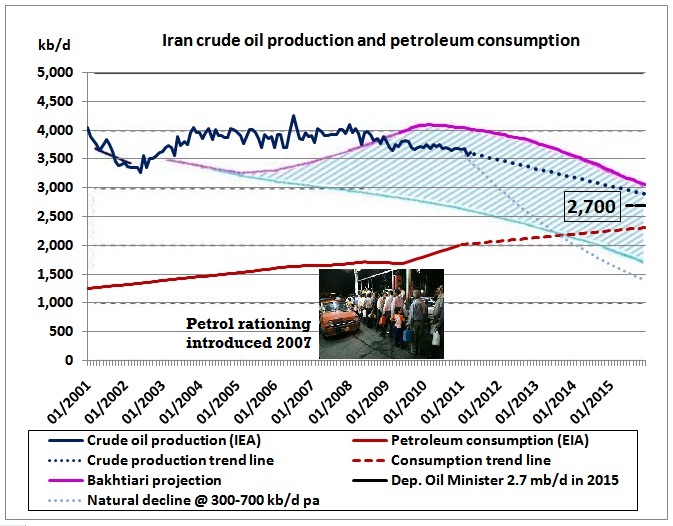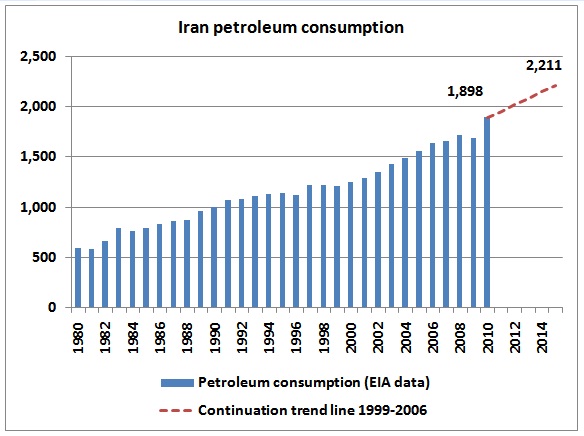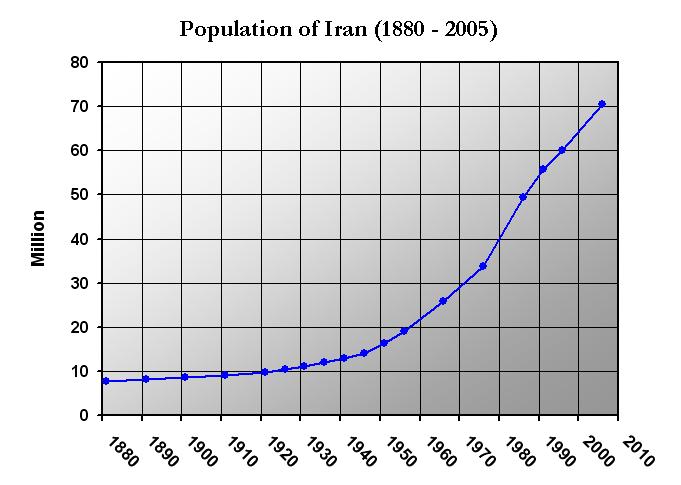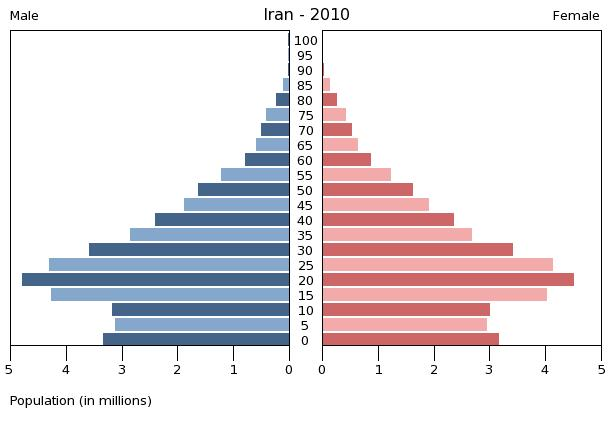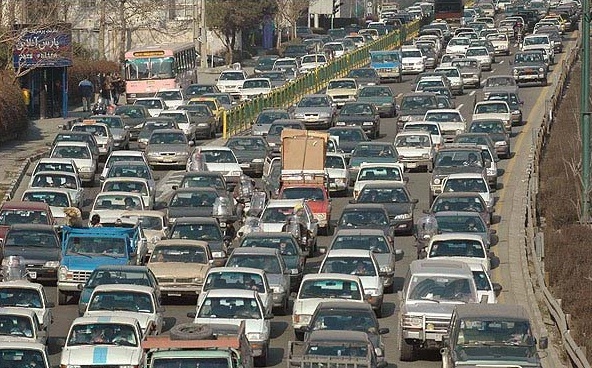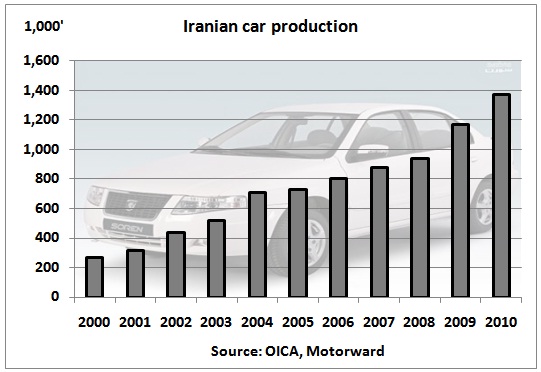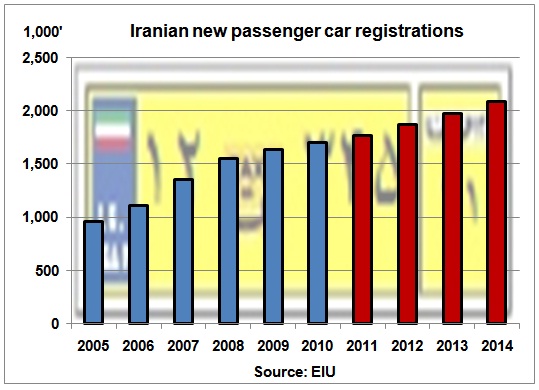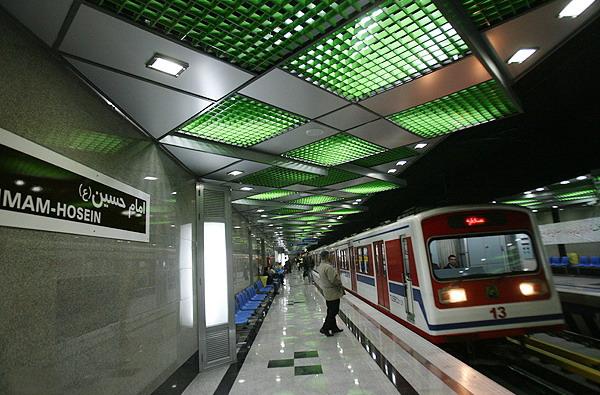The Iranian Deputy Oil Minister needs $150 bn in the next 5 years to stop rampant decline in maturing oil fields. If current production declines and consumption growth in Iran continue on their current paths Iran’s oil exports will drop from 1.8 mb/d in 2010 to just 500 kb/d in 5 years time. The socio economic consequences for Iran and changes in the geo-political situation in the Middle East will be dramatic.
AFP reports:
Iran’s oil production may fall to 2.7 million barrels per day within five years unless 150 billion dollars is invested in its energy sector, a top official said in a report on Monday.
“If the investments are not realised…, the country’s oil output will drop to 2.7 million barrels per day” from the current production of 3.7 million, he said.
According to Khojasteh-Mehr [deputy oil minister] , 75 billion dollars would be used to develop gas projects, 34 billion to develop oil fields, and 32 billion to maintain production capacity.
Sixty billion dollars would be financed by foreign investors despite tight economic and financial sanctions which world powers have imposed on Iran over its disputed nuclear programme, he said.
http://news.yahoo.com/s/afp/20110530/wl_mideast_afp/iraneconomyoilgas
The latest on Iran’s nuclear program:
IRAN’S NUCLEAR TIMETABLE
Updated May 25, 2011
On May 13, 2011, Iran was estimated by the IAEA to have accumulated 97 kg of U-235 in its stockpile of low-enriched UF6. Assuming 21.6 kg of this U-235 is needed per bomb, the 97 kg would be enough for four bombs by April 2011. http://www.iranwatch.org/ourpubs/articles/iranucleartimetable.html
The Energy Information Administration of the US Department of Energy explains on its web site on Iran what is happening in Iran’s oil fields:
Iran’s fields have a natural annual decline rate estimated at 8 percent onshore and 11 percent offshore, with recovery rates at 20-25 percent. An estimated 400,000-700,000 bbl/d of crude production is lost annually due to declines in the mature oil fields. To offset natural decline rates, Irans oil fields require structural upgrades including enhanced oil recovery efforts such as natural gas injection.
http://ei-01.eia.doe.gov/emeu/cabs/Iran/Oil.html (January 2010)
Let’s put that into a graph:
The graph superimposes past production and consumption plus future trend lines on Dr. Bakhtiari’s 2003 projection (blue shaded area). Current production is in the upper half of his estimate range. Australian Senators were informed by him on the transition phase T1 between growing and declining oil production already in July 2006
http://www.aph.gov.au/hansard/senate/commttee/S9515.pdf
but his warnings were not heeded.
After a slight dent in 2007, when petrol rationing was introduced, and in 2009 after the GFC, the consumption growth trend between 1999 and 2006 was back on track in 2010:
These production and consumption trends would leave just 500 kb/d for exports in 2015, down from 1.8 mb/d in 2010. The laws of the land export model
http://en.wikipedia.org/wiki/Export_Land_Model
dictate that exports fall much steeper than production. The socio economic implications of the process of oil export extinction in Iran will be as severe and dramatic as in the end 70s when Iran’s oil production peaked.
What are the growth factors in Iranian oil demand?
The population is now 77 million and growing, despite a slowing in the growth rate to 1.2 % pa
http://en.wikipedia.org/wiki/File:Iran_Population_(1880-2005).JPG
http://www.d-transition.info/countries-glance-3/iran-120/
The population is young, with many drivers making a living with taxi pools
http://www.flickr.com/photos/philsworldtravel/4077699758/
Traffic in Iran’s capital:
Oil burnt in Tehran traffic cannot be exported.
http://gdb.rferl.org/9B1E28C1-7D71-4F2A-A782-E52746FB8FA9_mw800_mh600.jpg
Car production is increasing:
New car registrations are increasing:
The quota system (quota per car) cannot solve the problem of a growing car fleet.
Tehran’s rail “network” is rudimentary for a city of 8 million:
http://www.johomaps.com/as/iran/tehran/tehranmetro.html
line 2: 20 km,
line 3: 24 km to be completed in 2014,
line 4: 6 km
Line 5: 41.5 km commuter train to Karadj
http://www.subways.net/iran/tehran.htm http://en.wikipedia.org/wiki/Tehran_Metro
http://upload.wikimedia.org/wikipedia/commons/6/68/Tehran_metroStation.jpg
Exports to these countries will shrink:
http://www.eia.gov/cabs/iran/Full.html
There are currency problems, too, the beginning of barter deals as oil markets start to fragment in the 2nd half of oil:
India to pay for Iranian crude oil in rupee
NEW DELHI: After having explored various options to make payments and having run out of them, India is understood to have decided to pay Iran for the crude oil supplied by it in rupee terms.
Under the newly floated but yet to be approved proposal,
National Iranian Oil Co (NIOC) will open rupee account with Indian banks and could use the money to purchase non-strategic items such as railway imports and buy commodities.
It will not be able to use the money to invest in India or for buying shares or companies.
The Finance Ministry will prepare and submit a list of do’s and don’ts for Iranian authorities from the money it gets as part of the crude oil payments.
The official said the Reserve Bank of India, which, in December last year, discontinued a long-standing mechanism of payment through central banks, previously opposed payments for Iranian oil in rupee but has now relented. In February, India started making euro payments through an Iranian bank based in Germany. But that had to be stopped soon after Germany came under pressure from the United States to put an end to this practice.
The government also explored the option of Indian oil firms opening accounts in Dubai-based Noor Islamic Bank for direct transfer of money to Iran. But the UAE is also learnt to have refused to route payments.
India imports 12 million barrels of crude oil every month from Iran, which is the nation’s second-largest supplier, after Saudi Arabia. The problem began after the RBI, on December 23, did away with the Asian Clearing Union (ACU) mechanism for paying for Iranian crude oil imports, which make up for 12 per cent of the nation’s oil needs.
http://www.hindu.com/2011/05/04/stories/2011050463531000.htm
Conclusion: While governments think they can afford the luxury to debate the global oil peak – as happened recently during the May 2011 budget hearings in the Australian Senate – much more critical is the peaking of oil production in strategically important countries in the Middle East like Iran. The fast oil export extinction which follows the peaking in the next years will bring about dramatic changes in geo-politics, resulting in a severe crisis for oil importing countries, the consequences of which have not been understood yet.
Previous posts:
30/12/2010 Another warning on Iran’s oil production and exports
http://crudeoilpeak.info/another-warning-on-iran%e2%80%99s-oil-production-and-exports
3/7/2010 Iran needs $130 oil to balance budget
IEA: Iran’s crude oil production to decline by 700 Kb/d by 2015
.
